Almost 63 years have passed since the deaths of nine ski hikers on the famous Dyatlov Pass, in the Ural Mountains of the then Soviet Union, and no one has been able to provide a convincing explanation of what really happened in February 1959, in a mystery that remains unsolved until today. The Magazine takes a look back at the fateful foray of Dyatlov's team, the disappearance of the expedition, the search for the missing, the discovery of the bodies and of course the major theories developed since then around the possible explanations for the admittedly strange circumstances under which the fatality occurred.
Let's start from the beginning, going back in time, to January 1959. It was then that 23-year-old Igor Dyatlov organized a group of ten people in total, for an expedition to the province (oblast) of Sverdlovsk, in the northern Urals (mountain range in Russia, 2,500 kilometers long, starting from the Arctic Ocean and ending in Kazakhstan, forming the natural border between Europe and Asia).
DYATLOF AND THE MEMBERS OF THE MISSION

Dyatlov was a graduate student at the Ural State Technical University in Yekaterinburg, the capital of the Ural Oblast. All the other members of the group - seven men and two women - were also students at the same school, except for 38-year-old Semyon Zolotaryov, who was a physical education teacher and tourism instructor in the area. The aim of the mission was to explore Mount Otorten (which in the dialect of the local Mansi tribe means "don't go there"), in the northern Urals.
All ten were experienced ski hikers with a 2nd category certification and upon their return, they would receive the 3rd category certification, which was the highest at the time in the Soviet Union, for which candidates had to cover at least 300 km. The route they had chosen, combined with the time they would be doing it (end of January-beginning of February), had been assessed as a test of maximum difficulty.
THE DEPARTURE OF THE MISSION

Dyatlov had undertaken all the planning of the mission and submitted it to the competent committee of the city of Sverdlovsk (present-day Yekaterinburg), which gave its approval to the team on January 8, 1959. On January 23, the committee presented Dyatlov with the official route book and the next day the ten left by train for the city of Ivdel (535 km north of Yekaterinburg), where they arrived at dawn on January 25.
They then boarded a truck, which took them to the village of Vizhai, the northernmost inhabited point in the region. They spent the night there and on the morning of the 27th they started the hike to Mount Otorten. The next day, on the 28th, one of the team members, Yuri Yudin, was unable to continue due to severe knee and joint pains and returned alone to Vizhai. Clearly disappointed when he was forced to abandon the others, he did not know at the time that he would be the sole survivor of that mission.

The rest continued their effort and today we know how their course developed in the next 24 hours, from the diaries and the films found in their scene. On January 31, the team reached a point where the ascent would begin and halted to make the necessary preparations. In a wooded valley, they stored food and equipment that they would use on the way back. On February 1st, climbing the mountain pass began.
Their goal was to reach the summit and camp on the other side before nightfall, but the worsening weather with a blizzard and reduced visibility caused them to lose their orientation, deviate from their course and move west, towards another neighboring mountain, Kolat Syakl ("mountain of death" in the local Mansi dialect). When they realized their mistake, they decided to pitch their tent on the side of the mountain, instead of going down a kilometer and a half to the foothills, where the forest would protect them much more from the bad weather.
THE RESCUE MISSION

It is very likely that they did not want to lose the altitude they had gained, which is why they decided to camp at that point. However, this was the last information we had from the calendars, since they stopped being updated on February 1st. Before they left Sverdlovsk, Dyatlov had agreed with their sports club to send a telegram as soon as the team returned to Vizhai. They had estimated that this would happen by February 12 at the latest, but when Yudin was unable to continue, Dyatlov told him that he thought it would take them longer after all.
When the agreed date passed, there was no immediate reaction, as it was usual for such shipments to be delayed by a few days. But on February 20, the families of the team members, now very worried, called for a rescue operation. Indeed, the first teams created by volunteer students and professors began the search for Dyatlov and the other members of the expedition, and a few days later, army and police forces were added, assisted by planes and helicopters.
THE SCENE AND THE DEAD

On February 26, rescuers found the tent of the missing, abandoned and almost destroyed, on a slope of Kolat Siakl. Mikhail Saravin, the student who first found the tent, later told authorities:"It was half-collapsed and covered in snow. There was no one inside, but all the team's equipment, including their shoes, was abandoned in there." The situation in which the scene was found, greatly confused the rescuers. Another thing that made a big impression on them was the fact that the tent had been torn from the inside.
Nine pairs of footprints started from the scene and led to the edge of a neighboring forest, on the opposite side of the pass, nearly a kilometer and a half to the northeast. The prints showed people either wearing only one shoe, only socks, or completely barefoot. After 500 meters from the scene, the footprints faded into the snow, but the rescuers continued their search and shortly after, under a pine tree, they discovered the remains of a small fire.

The first two bodies were found there, of Krivonichenko and Doroshenko (center photo of the text), who were barefoot and wearing only their underwear. The branches of the pine were broken up to a height of five meters, a sign that one of the two had probably climbed the tree to look for something, perhaps the location of the tent or the rest of the group.
Between the pine tree and the tent, the rescuers found three more bodies by March 5, Dyatlov (300 meters from the fire), Kolmogorova (480 m) and Slobodin (630 m). The position of all three indicated that they were trying to return to the stage. Slobodin had a small crack in his skull, but medical examiners concluded that the injury was not fatal. The final report gave hypothermia as the cause of death for all five, but no convincing explanation could be given as to why they left their tent.
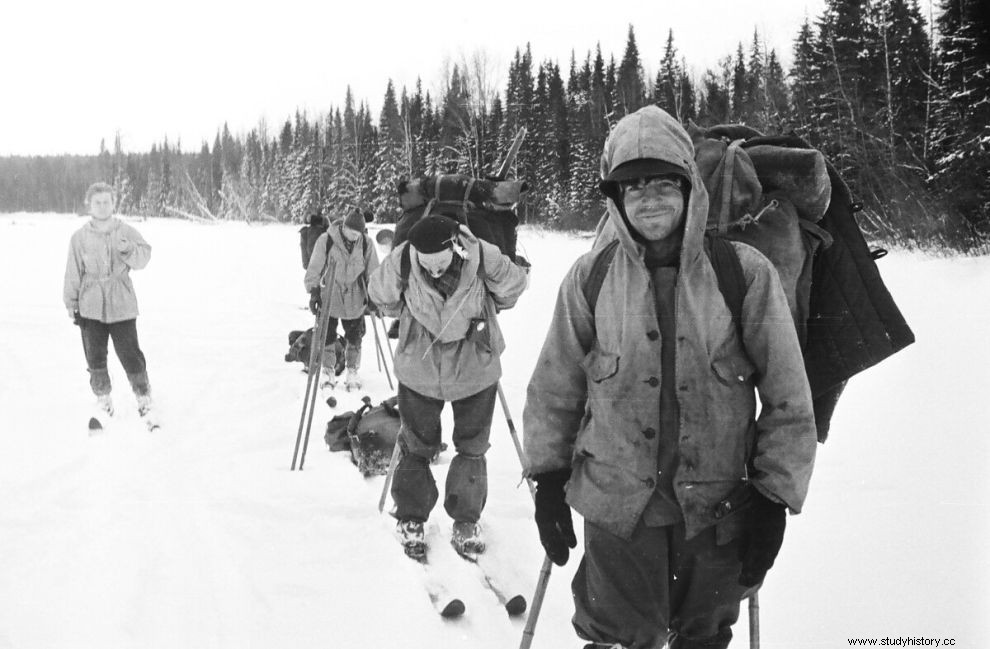
Searches continued to find what happened to the remaining four of the group (Kolevatov, Zolotaryov, Thibaut-Brignol and Dubinina) and finally, two months later, on May 4, the army discovered their bodies buried four meters under of snow, in a ravine in the forest, about 75 meters away from the pine tree. In contrast to the first five, the last four were clearly better dressed, while it was obvious that those who had remained alive had also taken clothes from the already dead.
For example, Zolotaryov was found wearing Dubinina's fur coat and hat, whose leg was wrapped with a piece of Krivonichenko's woolen trousers. But that was where the big twist in the investigation came, with the whole case now moving to a completely different level. And this, because three of the last four bodies found in the ravine had very bad, but also strange, fatal wounds on them.
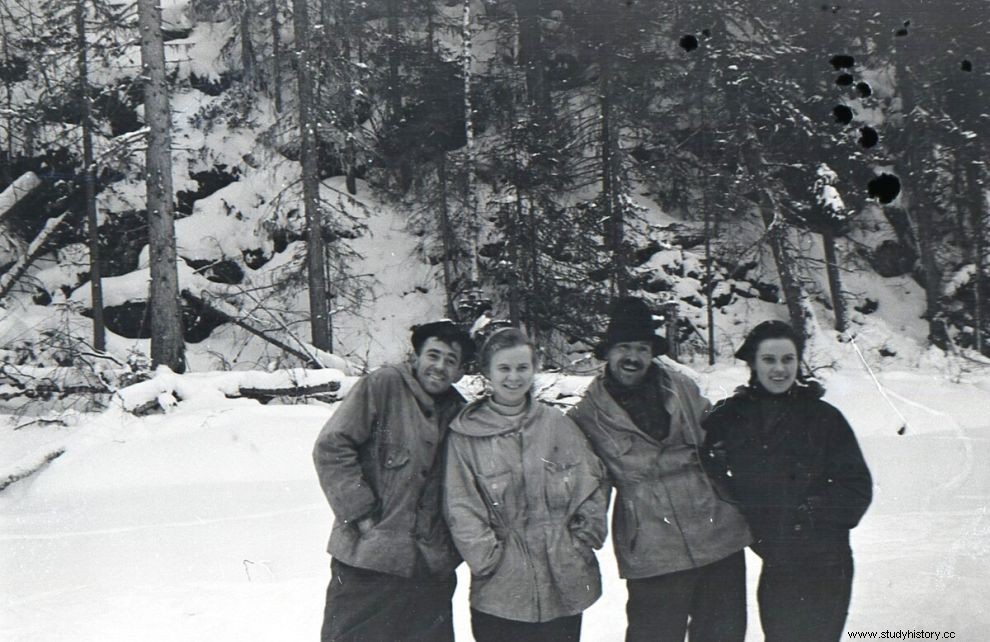
Dubinina and Zolotaryov had serious chest fractures, while Briniol had suffered a heavy blow to the head. There were no abrasions or bruises on any of the bodies, and Boris Vozrozdeny, the medical examiner who examined the four bodies, concluded that to cause such blows, such a great force was needed, similar to that of a strong collision in a car accident. He even added, confusing things even more, that these kinds of blows could not have been made by a human, since no soft tissue had been damaged at all.
As these corpses had no external injuries at all, the only explanation was that they had somehow been subjected to an unbearable, extremely high level of pressure, which had disintegrated their bodies internally. But there was continuity. Dubinina had her tongue and eyes removed - "with surgical precision" according to the coroner - while part of her lips, facial tissue and a fragment of her skull were missing. Zolotaryov was missing his eyeballs and Kolevatov his eyebrows.
THE FIRST HYPOTHESES ABOUT THE INCIDENT

Vozrozdeni concluded that the removal of the organs from the corpses took place after they had died. And as if all this were not enough, elevated levels of radioactivity were found in the clothes of the four, as well as in the bodies of the nine, but also in their equipment. According to rescuers, the last four found in the ravine had dug a rudimentary hiding place in the snow, which it had filled with branches to keep warm. But their bodies were found a few meters away from the improvised shelter.
Let's say here that after the discovery of the first five corpses, a judicial investigation was launched by a special committee, which, following the medical conclusion that death was due to hypothermia (the temperature varied between -25 and -30 degrees Celsius), simply waited finding the remaining four bodies to close the case, certain that the other members of the group had died from the same cause.

But everything we mentioned above about the last four, brought it up and down and completely changed the course of the investigation, which very quickly led to a dead end. The first suspicions fell on the Mansi, the indigenous tribe that inhabited the area. There was the possible scenario that these were the killers of the nine skiers, that they attacked and killed them for trespassing on their sacred ground. But very quickly this possibility was ruled out.
And this is because on the one hand, no traces were found in the area of the incident other than the members of the mission, while on the other hand, there were no signs of a physical struggle on any of the bodies. And of course, apart from these, the Mansi were known to be peaceful and nothing could connect them to such a crime. So, after questioning many residents of the tribe, the researchers found themselves back at "zero".
THE FINAL CONCLUSION

Journalists who gained access to some of the investigation files later stated that the most important elements contained in them were as follows:
- Six of the team members died from hypothermia and three from lethal blows.
- There were no indications of the presence of other people in Kolat Siakl, beyond the nine members of the group.
- The tent was torn from the inside.
- The victims had died six to eight hours after their last meal.
- The footprints outside the tent made it clear that all members of the group had left the camp site on foot and on their own initiative.
- In the documents there was no information about the internal organs of the group members.
The bottom line, however, was that the members of the commission that conducted the judicial investigation could not find convincing answers to a number of critical questions. Why did some of the expedition members come out of their tent either wearing only one shoe, only socks, or completely barefoot? Why were there such elevated levels of radioactivity in their bodies and equipment? And of course, how and by whom had the fatal blows to the three dead come about?
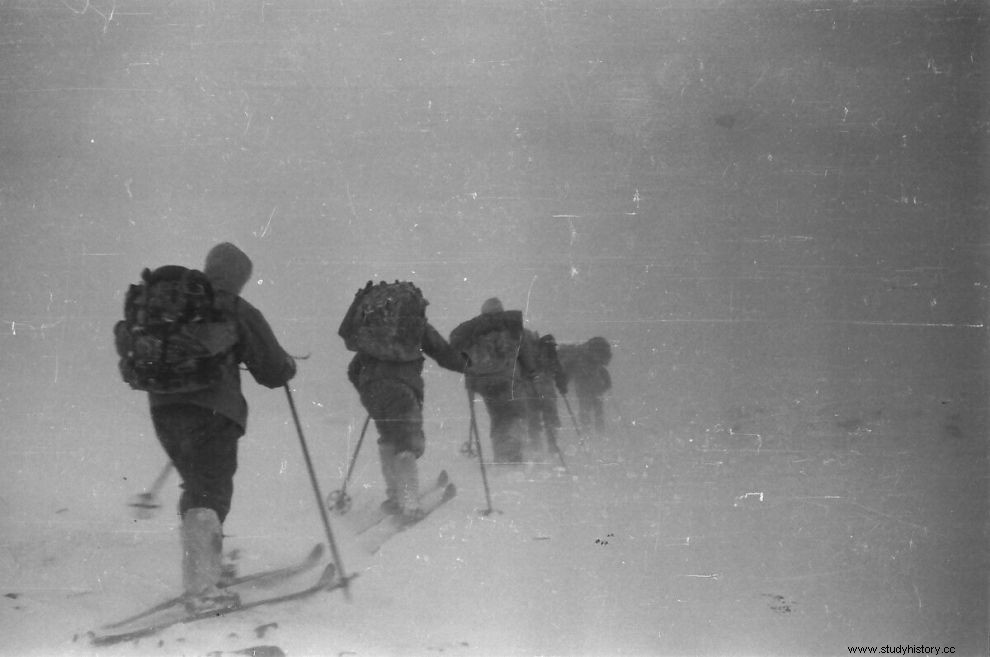
Finally the investigation was officially stopped in May 1959, after the impasse was complete. The official report said the death of the team members was caused by a "mighty natural force", without specifying what it was. All relevant documents were kept in a secret file. It was only after the fall of the Soviet Union in the 1990s that part of the file was made public, but key parts of the findings remain locked up to this day.
In 1997 it became known that the negatives from Krivonichenko's camera were in the personal file of the head of the investigative team on the incident, Lev Ivanov. Ivanov's daughter, Alexandra, donated the films to the Dyatlov Foundation, and the surviving diaries became the property of Russia in 2009. Efforts to bring the entire secret file of the case to light have failed, as the Russian ministry defense, as well as the Federal Security Service of the Russian Federation (FSB), refuse to make it public.

In 1999, the Dyatlov Foundation was founded in Yekaterinburg, with the support of the Ural State Technical University and Yuri Kuntsevich as president. The aim of the Foundation is to continue the investigation into the case, but also to preserve the memory of the nine victims through the Dyatlov Museum. The mountain pass in which the ski hikers tragically died was named the Dyatlov Pass, while memorials have been erected both at this point and at Yekaterinburg's "Mikhailovskoe" Cemetery.
But let's now move on to see what the theories have been that have been put forward over the years about what happened, in a mystery that continues to remain unsolved after so many decades and that will be difficult to explain, unless the Russians decide at some point to open up the secret file. It is important to say here that in February 2019, the Russian authorities re-launched an investigation into the case, but only looking into the possibilities of the avalanche and typhoon and completely leaving the case of criminal activity out of the equation.
THE THEORY OF THE SNOW LADDER
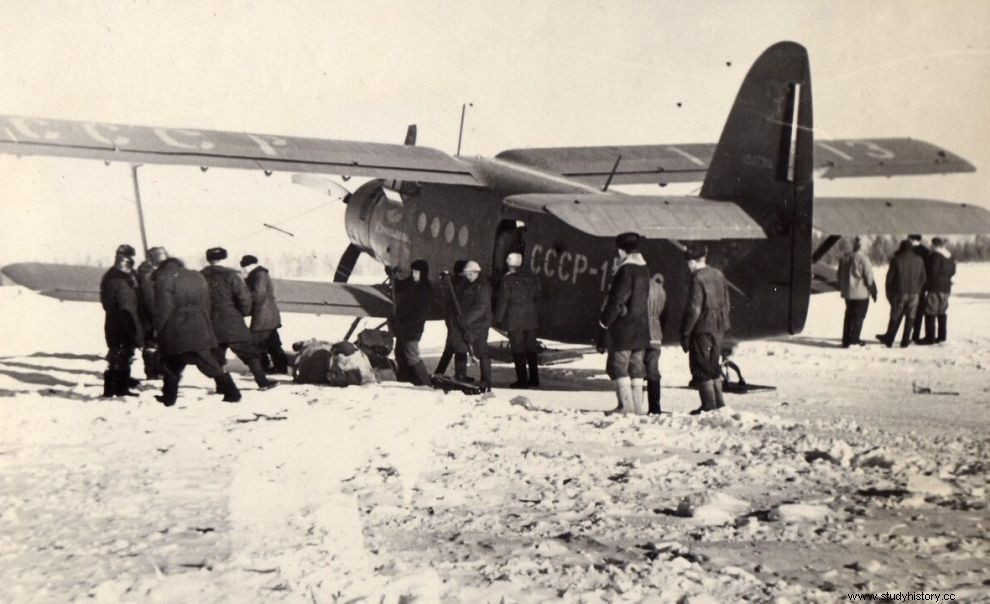
For the Mansi, which was also the theory supported as the most probable by the government of the Soviet Union, we said it above. It was ruled out, since there was not the slightest indication of their guilt, while, on the contrary, all the evidence showed that none of the tribe came into contact with Dyatlov's group. So we move on to the avalanche theory. So some argued that due to the intense bad weather, at some point an avalanche "hit" the tent, causing the nine to tear the tent from the inside and escape.
But nothing explains - if we accept this possibility - why nine experienced skiers left their tent without shoes and proper clothing in -30 degrees Celsius, knowing full well that this was tantamount to suicide. Also, precisely because they all had a lot of experience in this kind of extreme conditions, they knew very well where and how to set up their tent, to avoid the possibility of being in the path of an avalanche.

More than a hundred dispatches in the area after the incident reported no conditions that could trigger an avalanche, which would likely happen in April or May when the snow melts, but certainly not in February. Ένα ακόμα στοιχείο που απέκλειε αυτή τη θεωρία, ήταν ότι αν είχε όντως συμβεί κάτι τέτοιο, τότε θα είχε αφήσει πίσω συγκεκριμένα σημάδια ή μοτίβα, όπως για παράδειγμα κατεστραμμένα δέντρα, έστω στις κορυφές τους.
Τέλος, ανάλυση του εδάφους που έγινε από ειδικούς, εξετάζοντας τη θέση και την κλίση στο σημείο που βρισκόταν η σκηνή, απέδειξε ότι ακόμα και αν είχε υπάρξει χιονοστιβάδα, η πορεία που θα είχε, θα παρέκαμπτε τη σκηνή, η οποία είχε καταρρεύσει πλευρικά, αλλά όχι οριζόντια. Θα περάσουμε στις επόμενες θεωρίες, όμως αμέσως μετά θα επιστρέψουμε στην χιονοστιβάδα, αφού νέες μελέτες που έγιναν τα τελευταία χρόνια, υποδεικνύουν τελικά αυτήν ως την πιθανότερη αιτία του θανάτου της ομάδας του Ντιάτλοφ.
Η ΘΕΩΡΙΑ ΤΟΥ ΚΑΤΑΒΑΤΙΚΟΥ ΑΝΕΜΟΥ

Το 2019, μια Ρωσο-Σουηδική αποστολή, έφτασε στο σημείο του συμβάντος και μετά από επιτόπια έρευνα, κατέληξε στο συμπέρασμα ότι για το περιστατικό ίσως να ήταν "ένοχος" ένας βίαιος καταβατικός άνεμος (εκείνος που πνέει προς τα κάτω από τις κορυφές βουνών και κάποιες φορές μπορεί να φτάσει σε πολύ μεγάλη ένταση και να γίνει εξαιρετικά επικίνδυνος). Κάτι τέτοιο είχε συμβεί το 1978 στη Σουηδία, σε παρόμοια τοπογραφία με αυτή του περάσματος Ντιάτλοφ, με οκτώ πεζοπόρους νεκρούς και έναν ακόμα βαριά τραυματισμένο.
Η υπόθεση που είχε γίνει, ήταν ότι με έναν ξαφνικό καταβατικό άνεμο, θα ήταν αδύνατο για τους εννιά να παραμείνουν μέσα στη σκηνή και η πιο λογική αντίδραση θα ήταν να βγουν από αυτή, να την σκεπάσουν με χιόνι και να αναζητήσουν καταφύγιο μέσα στο δάσος. Συνέδεσαν μάλιστα αυτό το πιθανό σενάριο, με το γεγονός ότι πάνω στη σκηνή βρέθηκε ένας φακός αναμμένος, για τον οποίο υπέθεσαν ότι ίσως είχε αφεθεί έτσι επίτηδες από τους εννιά, ώστε να τους βοηθήσει να ξαναβρούν τη σκηνή όταν θα σταματούσε ο καταβατικός άνεμος.
Η ΘΕΩΡΙΑ ΤΩΝ ΥΠΟΗΧΩΝ

Εδώ έχουμε μια άλλη θεωρία, η οποία έγινε πολύ δημοφιλής, εξαιτίας του βιβλίου του Ντόνι Έικαρ, "Dead Mountain:The untold true story of the Dyatlov Pass incident", που κυκλοφόρησε το 2013. Σε αυτό, ο συγγραφέας μιλάει για την πιθανότητα δημιουργίας της περίφημης "Kármán vortex street", δηλαδή των μεγάλων αλυσίδων από σπειροειδείς δίνες, που σχηματίζονται όταν η ροή του ρευστού διαταράσσεται από κάποιο αντικείμενο, στην περίπτωσή μας από τους ισχυρούς ανέμους στην κορυφή του Κόλατ Σιάκλ.
Αυτές οι δίνες μπορούν να παράγουν υπόηχους (ήχους των οποίων η συχνότητα είναι χαμηλότερη από το κατώτατο όριο συχνοτήτων που μπορούν να γίνουν αντιληπτές από την ανθρώπινη ακοή), οι οποίοι έχει διαπιστωθεί ότι προκαλούν ανησυχία, φόβο, δυσφορία και πανικό στους ανθρώπους. Ο Έικαρ υποστηρίζει ότι οι εννιά πανικοβλήθηκαν, έφυγαν από τη σκηνή και κατέβηκαν την πλαγιά. Μόλις έφτασαν χαμηλά, βγήκαν από τη ζώνη επιρροής των υπόηχων, συνήλθαν, αλλά μέσα στο σκοτάδι δεν μπόρεσαν να ξαναβρούν τη σκηνή. Καταλήγει λέγοντας ότι οι τρεις από αυτούς, έπεσαν στο διπλανό φαράγγι και προσγειώθηκαν πάνω στους βράχους, όπου υπέστησαν τους θανατηφόρους τραυματισμούς.
Η ΘΕΩΡΙΑ ΤΩΝ ΣΤΡΑΤΙΩΤΙΚΩΝ ΔΟΚΙΜΩΝ
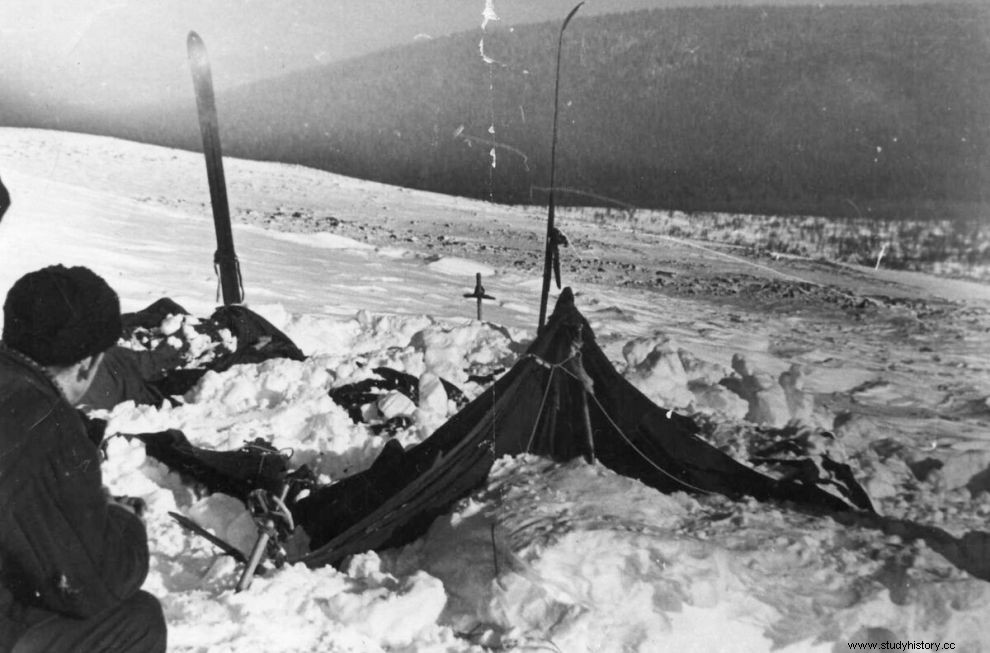
Μια άλλη, πολύ διαδεδομένη θεωρία, σχετίζεται με στρατιωτικές δοκιμές του σοβιετικού στρατού. Σύμφωνα με αυτήν, η ομάδα του Ντιάτλοφ βρέθηκε καταλάθος στο επίκεντρο στρατιωτικής άσκησης, που έπρεπε να μείνει μυστική. Κάποιοι μιλάνε για δοκιμαστικές ρίψεις ναρκών με αλεξίπτωτα. Υποτίθεται ότι οι εννιά ξύπνησαν από τις δυνατές εκρήξεις και πανικοβλημένοι έτρεξαν μακριά από τη σκηνή για να βρουν προστασία κοντά στο δάσος. Αυτές οι νάρκες εκρήγνυνται στον αέρα, λίγα μέτρα πριν φτάσουν στην επιφάνεια της γης και προκαλούν σοβαρούς εσωτερικούς τραυματισμούς, σαν αυτούς που είχαν οι τρεις από τους εννιά πεζοπόρους.
Αυτή η θεωρία ενισχύθηκε και από το γεγονός ότι στην ευρύτερη περιοχή είχαν παρατηρηθεί εκείνη τη νύχτα λαμπερές πορτοκαλί σφαίρες, που ερμηνεύτηκαν ως στρατιωτικά αεροπλάνα ή αλεξίπτωτα ή ίχνη που άφησαν οι ίδιες οι εκρήξεις. Υπάρχει και μια άλλη εκδοχή, που μιλάει για πιθανή μυστική δοκιμή ραδιενεργών όπλων, κάτι που εξηγεί την παρουσία τόσο υψηλών τιμών ραδιενέργειας στα εννιά πτώματα και τον εξοπλισμό τους. Όσοι υποστηρίζουν αυτή την εκδοχή, προσθέτουν ένα ακόμα επιχείρημα.

Αναφέρουν ότι ο επικεφαλής της ερευνητικής ομάδας, ο Λεβ Ιβανόφ, είχε μαζί του μετρητή Geiger για τη ραδιενέργεια, κάτι τελείως αφύσικο για διασώστες που έψαχναν σκιέρ χαμένους μέσα στα χιόνια. Πολλοί ήταν πάντως οι μάρτυρες που ανέφεραν ότι το δέρμα στα εννιά πτώματα είχε σκούρο καφέ χρώμα, κάτι που υποδεικνύει δηλητηρίαση από φώσφορο. Τέλος, έχουμε και μια ακόμα θεωρία που σχετίζεται με τον σοβιετικό στρατό και έχει να κάνει με την κατασκοπεία.
Σύμφωνα με αυτή την εκδοχή, η ομάδα του Ντιάτλοφ δέχτηκε επίθεση από σοβιετικούς στρατιώτες, οι οποίοι υποπτεύονταν πως οι σκιέρ είχαν τραβήξει φωτογραφίες από τα αεροπλάνα που πετούσαν στην περιοχή πραγματοποιώντας τις μυστικές δοκιμές. Υποτίθεται ότι προσγειώθηκαν στην περιοχή με ελικόπτερο, κυνήγησαν τους εννιά στο σκοτάδι, σκότωσαν τους τρεις και έφυγαν χωρίς να αφήσουν ίχνη. Μια υπόθεση φυσικά, η οποία μπάζει από παντού, αφού δεν υπήρχε περίπτωση να αφήσουν ζωντανούς τους υπόλοιπους, ρισκάροντας να μαθευτεί το συμβάν.
Η ΘΕΩΡΙΑ ΤΟΥ "ΠΑΡΑΔΟΞΟΥ ΓΔΥΣΙΜΑΤΟΣ"

Ακολουθεί η θεωρία που δημοσιεύτηκε για πρώτη φορά το 2012 από τους International Science Times και έχει να κάνει με ένα φαινόμενο σχετιζόμενο με την υποθερμία. Η οποία υποθερμία είναι η μείωση της εσωτερικής θερμοκρασίας του σώματος κάτω από τους 35 βαθμούς Κελσίου και συμβαίνει όταν ο οργανισμός χάνει θερμότητα με μεγαλύτερο ρυθμό από ό,τι παράγει. Ένα από τα συμπτώματα της ακραίας υποθερμίας είναι το λεγόμενο "παράξενο γδύσιμο" (paradoxical undressing).
Σύμφωνα με αυτό, τα θύματα της υποθερμίας, που ήδη βρίσκονται σε σύγχυση και αποπροσανατολισμό (με τον ρυθμό της αναπνοής και των χτύπων της καρδιάς να έχει επιβραδυνθεί επικίνδυνα), νιώθουν ξαφνικά ένα αφόρητο κύμα ζέστης και βγάζουν τα ρούχα τους, αυξάνοντας έτσι την απώλεια θερμότητας. Στην έρευνα υποστηρίχτηκε πως αυτή ήταν η αιτία θανάτου της ομάδας του Ντιάτλοφ και ο λόγος που τα πτώματα βρέθηκαν ντυμένα με ελάχιστα ρούχα. Σήμερα γνωρίζουμε ότι οι έξι από τους εννιά πέθαναν σίγουρα από υποθερμία, όμως κάποιοι είχαν φορέσει επιπλέον ρούχα που πήραν από τους ήδη νεκρούς, σημάδι ότι είχαν το καθαρό μυαλό να το πράξουν, άρα δεν βρίσκονταν στη σύγχυση που προκαλεί η κατάσταση την οποία περιγράψαμε.
Η ΘΕΩΡΙΑ ΤΟΥ ΓΕΤΙ
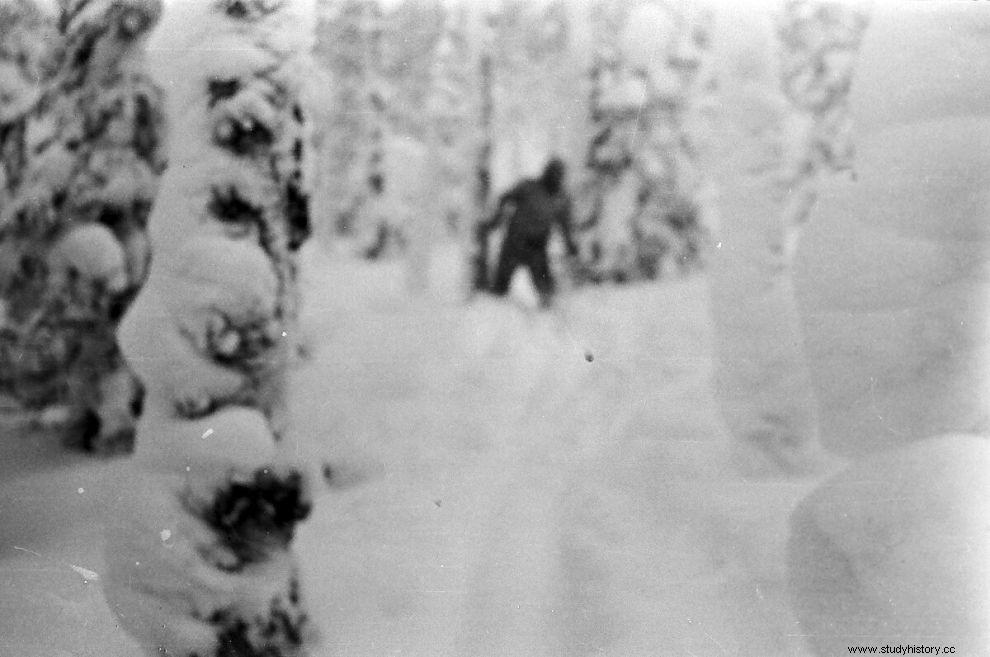
Επόμενη θεωρία είναι αυτή που αφορά τη λεγόμενη κρυπτοζωολογία, η οποία ασχολείται με την αναζήτηση και τη μελέτη ζωικών οργανισμών που δεν βρίσκονται στους επίσημους ζωολογικούς καταλόγους, είτε γιατί έχουν εκλείψει, είτε γιατί η ύπαρξή τους αναφέρεται μόνο σε μύθους, θρύλους και παραδοσιακές αφηγήσεις. Στο ντοκιμαντέρ του Discovery Channel, "Russian Yeti, the killer lives" (Ρωσικό Γέτι, ο δολοφόνος ζει) που βγήκε στον αέρα το 2014, εξετάστηκε η θεωρία κάποιων κρυπτοζωολόγων, σύμφωνα με την οποία, η ομάδα του Ντιάτλοφ δολοφονήθηκε από το μυθικό Γέτι.
Το σενάριο αυτό στηρίχτηκε σε μεγάλο βαθμό στην τελευταία φωτογραφία που βρέθηκε στην κάμερα της Κολμογκόροβα και η οποία απεικονίζει μια άγνωστη, μεγαλόσωμη μορφή μέσα στο δάσος, που υποτίθεται ότι παραπέμπει σε Γέτι. Κάποιοι υποστηρίζουν ότι πρόκειται για τον Τιμπό Μπρινιόλ, το σίγουρο είναι ότι αυτή η θεωρία στερείται οποιασδήποτε σοβαρότητας, ειδικότερα από τη στιγμή που μέχρι σήμερα δεν έχει αποδειχθεί η ύπαρξη του Γέτι.
ΑΚΟΜΑ ΠΕΡΙΣΣΟΤΕΡΕΣ ΘΕΩΡΙΕΣ

Πέρα από τις προαναφερθείσες θεωρίες, που είναι και οι σημαντικότερες, όλα αυτά τα χρόνια έχουν κυκλοφορήσει αρκετές ακόμα, στην προσπάθεια να βρεθεί μια πειστική εξήγηση για το τί πραγματικά συνέβη στην ομάδα του Ντιάτλοφ. Ενδεικτικά να αναφέρουμε εν συντομία κάποιες από αυτές. Υπάρχει εκείνη που λέει ότι τους επιτέθηκαν και τους σκότωσαν άγρια ζώα, χωρίς όμως να έχει βρεθεί το παραμικρό ίχνος στην περιοχή γύρω από τη σκηνή. Υπάρχει μια άλλη, σύμφωνα με την οποία, οι θυελλώδεις άνεμοι περέσυραν ένα από τα μέλη της αποστολής και οι υπόλοιποι έτρεξαν να το σώσουν. Μάλλον ασχολίαστο...
Ένα τρίτο σενάριο μιλάει για μια ρομαντική συνάντηση δυο εκ των μελών εκτός σκηνής, που εξελίχθηκε σε βίαιη διαμάχη, κάτι όμως που απορρίπτεται από το γεγονός ότι οι σχέσεις μεταξύ των εννιά ήταν αρμονικές, ενώ δεν υπήρχαν ούτε ναρκωτικά, ούτε αλκοόλ. Τέλος, να αναφέρουμε και την περίπτωση της ρίψης από αμερικανικό κατασκοπευτικό αεροπλάνο της λεγόμενης photoflash βόμβας, η οποία εκρήγνυται στον αέρα και φωτίζει την περιοχή, ώστε να φωτογραφηθεί χωρίς να χρειαστεί χαμηλή πτήση. Από αποχαρακτηρισμένα έγγραφα των ΗΠΑ έχει αποδειχθεί ότι στο πρώτο μισό του 1959 είχαν γίνει τέτοιες ρίψεις στην ευρύτερη περιοχή του συμβάντος. Υποτίθεται ότι η έκρηξη και το φως τρόμαξαν τους εννιά, που έφυγαν από τη σκηνή τους και πέθαναν από το κρύο.
ΕΠΙΣΤΡΟΦΗ ΣΤΗ ΘΕΩΡΙΑ ΤΗΣ ΧΙΟΝΟΣΤΙΒΑΔΑΣ
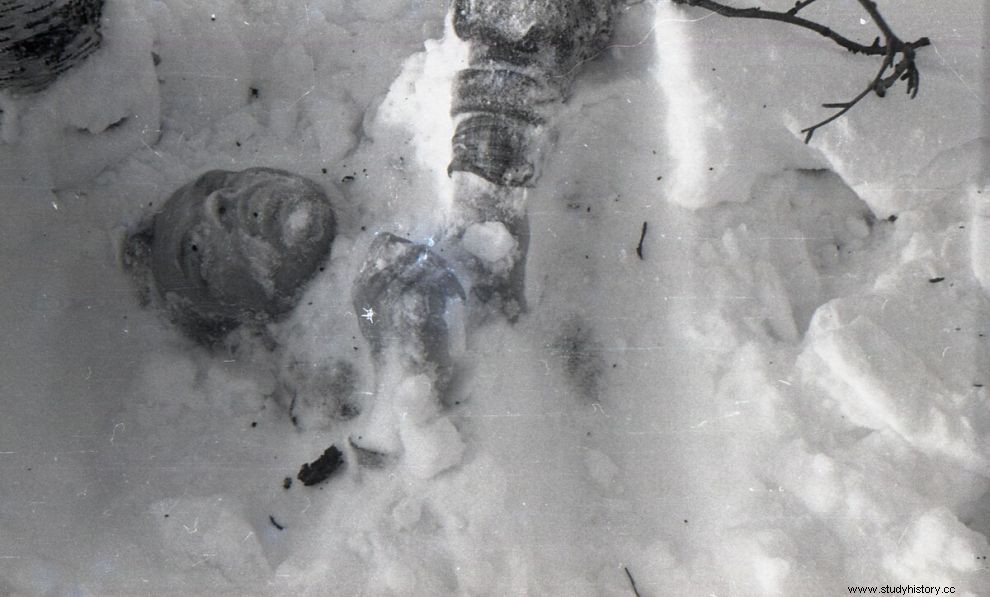
Αφού αναφερθήκαμε στις διάφορες θεωρίες που έχουν γραφτεί μέχρι σήμερα, επιστρέφουμε σε αυτήν της χιονοστιβάδας, ακριβώς επειδή αυτή προέκυψε ως η πιθανότερη αιτία του θανάτου της ομάδας του Ντιάτλοφ, μετά από νέες έρευνες που έγιναν από το 2015 μέχρι το 2019 υπό την αιγίδα της Ερευνητικής Επιτροπής της Ρωσικής Ομοσπονδίας (ICRF) και ύστερα από αίτημα των οικογενειών των εννέα νεκρών. Τα μέλη της επιτροπής, έμπειροι σκιέρ, αλπινιστές και ορειβάτες, έλαβαν υπόψη τους όλες τις παραμέτρους και κατέληξαν στο πόρισμά τους.
Καταρχάς, τη νύχτα της τραγωδίας, οι καιρικές συνθήκες ήταν πολύ άσχημες, η ταχύτητα των ανέμων κυμαινόταν από 72 έως 108 χιλιόμετρα την ώρα, πλησιάζοντας τις ταχύτητες ενός τυφώνα, υπήρχε σε εξέλιξη τρομερής έντασης χιονοθύελλα και η θερμοκρασία είχε αγγίξει τους -40 βαθμούς Κελσίου. Όλα αυτά ήταν άγνωστα στους ερευνητές του 1959, που έφτασαν στο σημείο της κατασκήνωσης τρεις εβδομάδες μετά το συμβάν, όταν ο καιρός είχε βελτιωθεί αισθητά και τα απομεινάρια της χιονοστιβάδας είχαν εξαφανιστεί κάτω από ένα νέο στρώμα χιονιού. Οι ερευνητές πιστεύουν λοιπόν ότι το συμβάν εξελίχθηκε ως εξής:
- Η ομάδα έφτασε την 1η Φεβρουαρίου στο Κόλατ Σιάκλ και έστησε μια μεγάλη σκηνή εννέα ατόμων σε ανοιχτή πλαγιά, χωρίς τη φυσική προστασία που θα μπορούσε να προσφέρει το δάσος.
- Στήνοντας τη σκηνή σε κλίση πάνω στην πλαγιά, δεν είχαν δυνατό κράτημα πάνω στο χιόνι. Έτσι, όταν τη νύχτα έπεσε η χιονοστιβάδα, το καινούργιο χιόνι που στοιβάχτηκε πάνω στη σκηνή, άρχισε να μετακινεί με το βάρος του σιγά-σιγά τα στηρίγματα, πιέζοντας όλο και περισσότερο το ύφασμά της και κλείνοντας τελείως το άνοιγμα της εισόδου. Μόλις ξύπνησαν, πανικοβλήθηκαν και μόνο μερικοί από αυτούς πρόλαβαν να ντυθούν με ζεστά ρούχα.
- Με την είσοδο τελείως μπλοκαρισμένη, άνοιξαν μια τρύπα στο πλάι της σκηνής, βγήκαν από μέσα και άρχισαν να κατεβαίνουν την πλαγιά για ενάμισι χιλιόμετρο, μέχρι να φτάσουν στη σχετική ασφάλεια του δάσους.
- Επειδή κάποιοι από τους εννιά δεν ήταν καλά ντυμένοι, η ομάδα χωρίστηκε. Δυο από αυτούς, φορώντας μόνο εσώρουχα και πιτζάμες, βρέθηκαν κάτω από το πεύκο, έχοντας πεθάνει από υποθερμία.
- Τρεις από την ομάδα, ανάμεσά τους και ο Ντιάτλοφ, προσπάθησαν να σκαρφαλώσουν ξανά την πλαγιά για να επιστρέψουν στη σκηνή και - πιθανότατα - να πάρουν μαζί τους υπνόσακους. Αυτοί οι τρεις ήταν καλύτερα ντυμένοι από τους προηγούμενους δυο, όμως όχι τόσο καλά όσο χρειαζόταν, ενώ δε φορούσαν καν παπούτσια. Τα πτώματά τους βρέθηκαν σε διαφορετικές αποστάσεις από τη φωτιά κάτω από το πεύκο, όλα σε στάσεις που υποδήλωναν πως είχαν σωριαστεί στο χιόνι εξαντλημένοι από την υπερπροσπάθεια να φτάσουν στη σκηνή.
- Οι εναπομείναντες τέσσερις, οι μόνοι με ζεστά ρούχα και παπούτσια, προσπαθούσαν να βρουν ένα κατάλληλο μέρος μέσα στο δάσος για να στήσουν ένα πρόχειρο κατάλυμα μέχρι να περάσει ο κίνδυνος. Τα πτώματά τους βρέθηκαν 75 μέτρα μακριά από τη φωτιά, κάτω από αρκετά μέτρα χιονιού και με τραύματα που υποδήλωναν ότι είχαν πέσει στο κενό από μια τρύπα που είχε καλυφθεί από το χιόνι, πάνω από ένα ρέμα.
Σύμφωνα με το τελικό πόρισμα των ερευνητών του ICRF, οι βασικοί παράγοντες που συνέβαλαν στην τραγωδία, ήταν τα ακραία καιρικά φαινόμενα που συνάντησε η ομάδα και η έλλειψη εμπειρίας του Ντιάτλοφ σε τέτοιες συνθήκες, που οδήγησε στην επιλογή ενός επικίνδυνου σημείου για το στήσιμο της σκηνής. Μετά τη χιονοστιβάδα, ένα άλλο λάθος ήταν ότι η ομάδα χωρίστηκε, αντί να παραμείνει ενωμένη και να φτιάξει ένα πρόχειρο κατάλυμα, προσπαθώντας να επιβιώσει μέσα στη νύχτα.

Η αναφορά του ICRF κατέληγε, λέγοντας ότι οι αμέλειες στην έρευνα του 1959, ήταν εκείνες που δημιούργησαν περισσότερα ερωτηματικά παρά απαντήσεις, προκαλώντας παράλληλα αναρίθμητες θεωρίες συνωμοσίας. Τον Ιανουάριο του 2021, μια ομάδα φυσικών και μηχανικών, δημοσίευσε στο επιστημονικό περιοδικό Communications Earth &Environment, ένα καινούργιο ερευνητικό μοντέλο, σύμφωνα με το οποίο, μια σχετικά μικρή χιονοστιβάδα στο Κόλατ Σιάκλ, θα μπορούσε να προκαλέσει ζημιές στη σκηνή και τραυματισμούς ανάλογους με εκείνους που υπέστησαν τα μέλη της ομάδας.
Βέβαια, κανείς από την ομάδα του ICRF δεν απάντησε ποτέ στο τόσο φλέγον ερώτημα, γιατί μέχρι και σήμερα, μέρος από το μυστικό αρχείο που βρίσκεται στην κατοχή της Ρωσικής κυβέρνησης, παραμένει επτασφράγιστο μυστικό, με την πρόσβαση σε αυτό απαγορευμένη σε οποιονδήποτε, ακόμα και στις οικογένειες των νεκρών, αλλά και στο ίδιο το Ίδρυμα Ντιάτλοφ. Μόνο όταν αυτό δοθεί στη δημοσιότητα, θα μάθουμε όλη την αλήθεια για το τί πραγματικά συνέβη τη νύχτα της 1ης Φεβρουαρίου του 1959 στο "βουνό του θανάτου".
